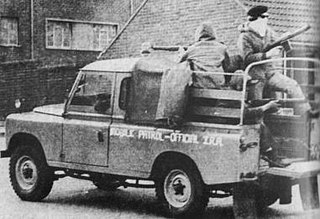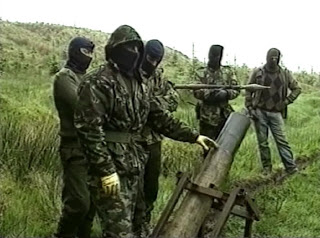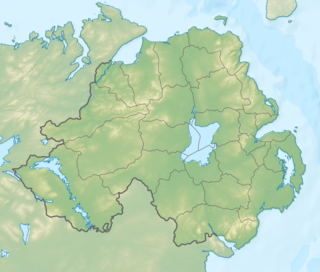The Irish Republican Army is any of several armed movements dedicated to Irish republicanism.

The Irish Republican Army (IRA) are paramilitary movements in Ireland in the 20th and the 21st century dedicated to Irish republicanism, the belief that all of Ireland should be an independent republic from British rule and free to form their own government. The original Irish Republican Army formed in 1917 from those Irish Volunteers who did not enlist in the British Army during World War I, members of the Irish Citizen Army and others. Irishmen formerly in the British Army returned to Ireland and fought in the Irish War of Independence. During the Irish War of Independence it was the army of the Irish Republic, declared by Dáil Éireann in 1919. Some Irish people dispute the claims of more recently created organisations that insist that they are the only legitimate descendants of the original IRA, often referred to as the "Old IRA". The playwright and former IRA member Brendan Behan once said that the first issue on any Irish organisation's agenda was "the split". For the IRA, that has often been the case. The first split came after the Anglo-Irish Treaty in 1921, with supporters of the Treaty forming the nucleus of the National Army of the newly created Irish Free State, while the anti-treaty forces continued to use the name Irish Republican Army. After the end of the Irish Civil War (1922–23), the IRA was around in one form or another for forty years, when it split into the Official IRA and the Provisional IRA in 1969. The latter then had its own breakaways, namely the Real IRA and the Continuity IRA, each claiming to be the true successor of the Army of the Irish Republic.
Irish Republican Army may also refer to:
- Irish Republican Army (1919–1922), the original organisation, who fought in the Irish War of Independence and were recognised as the official army of the Irish Republic.
- Irish Republican Army (1922–1969), the faction of the "Old IRA" who opposed the Anglo-Irish Treaty after the war.
- Irish Republican Army, or Official Irish Republican Army, one faction of the IRA following a split in 1969, active until 1973.
- Irish Republican Army, or Provisional Irish Republican Army, the other faction of the IRA following the 1969 split, active until 2005.
- Irish Republican Army, or Continuity Irish Republican Army, which emerged from a split in the Provisional IRA over abstentionism, active since 1986.
- Irish Republican Army, or Real Irish Republican Army, which emerged from a split in the Provisional IRA over the 1997 ceasefire, active since that time.

The Irish Republican Army (IRA) was an Irish republican revolutionary paramilitary organisation. The ancestor of many groups also known as the Irish Republican Army, and distinguished from them as the Old IRA, it was descended from the Irish Volunteers, an organisation established on 25 November 1913 that staged the Easter Rising in April 1916. In 1919, the Irish Republic that had been proclaimed during the Easter Rising was formally established by an elected assembly, and the Irish Volunteers were recognised by Dáil Éireann as its legitimate army. Thereafter, the IRA waged a guerrilla campaign against the British occupation of Ireland in the 1919–21 Irish War of Independence.

The original Irish Republican Army (IRA) fought a guerrilla war against British rule in Ireland in the Irish War of Independence between 1919 and 1921. Following the signing of the Anglo-Irish Treaty on 6 December 1921, the IRA in the 26 counties that were to become the Irish Free State split between supporters and opponents of the Treaty. The anti-Treatyites, sometimes referred to by Free State forces as Irregulars, continued to use the name Irish Republican Army (IRA) or in Irish Óglaigh na hÉireann, as did the organisation in Northern Ireland which originally supported the pro-Treaty side. Óglaigh na hÉireann was also adopted as the name of the pro-Treaty National Army, and remains the official legal title of the Irish Defence Forces. This article deals with the anti-Treaty IRA that fought against the Irish Free State in the Irish Civil War, and with its successors up to 1969, when the IRA split again.

The Official Irish Republican Army or Official IRA was an Irish republican paramilitary group whose goal was to remove Northern Ireland from the United Kingdom and create a "workers' republic" encompassing all of Ireland. It emerged in December 1969, shortly after the beginning of the Troubles, when the Irish Republican Army split into two factions. The other was the Provisional IRA. Each continued to call itself simply "the IRA" and rejected the other's legitimacy. Unlike the "Provisionals", the "Officials" didn’t think that Ireland could be unified until the Protestant majority and Catholic minority were at peace with each other, they were Marxist and worked to form a united front with other Irish communist groups, named the Irish National Liberation Front (NLF). The Officials were called the NLF by the Provisionals and were sometimes nicknamed the "Red IRA" by others.
| This disambiguation page lists articles associated with the title Irish Republican Army. If an internal link led you here, you may wish to change the link to point directly to the intended article. |






